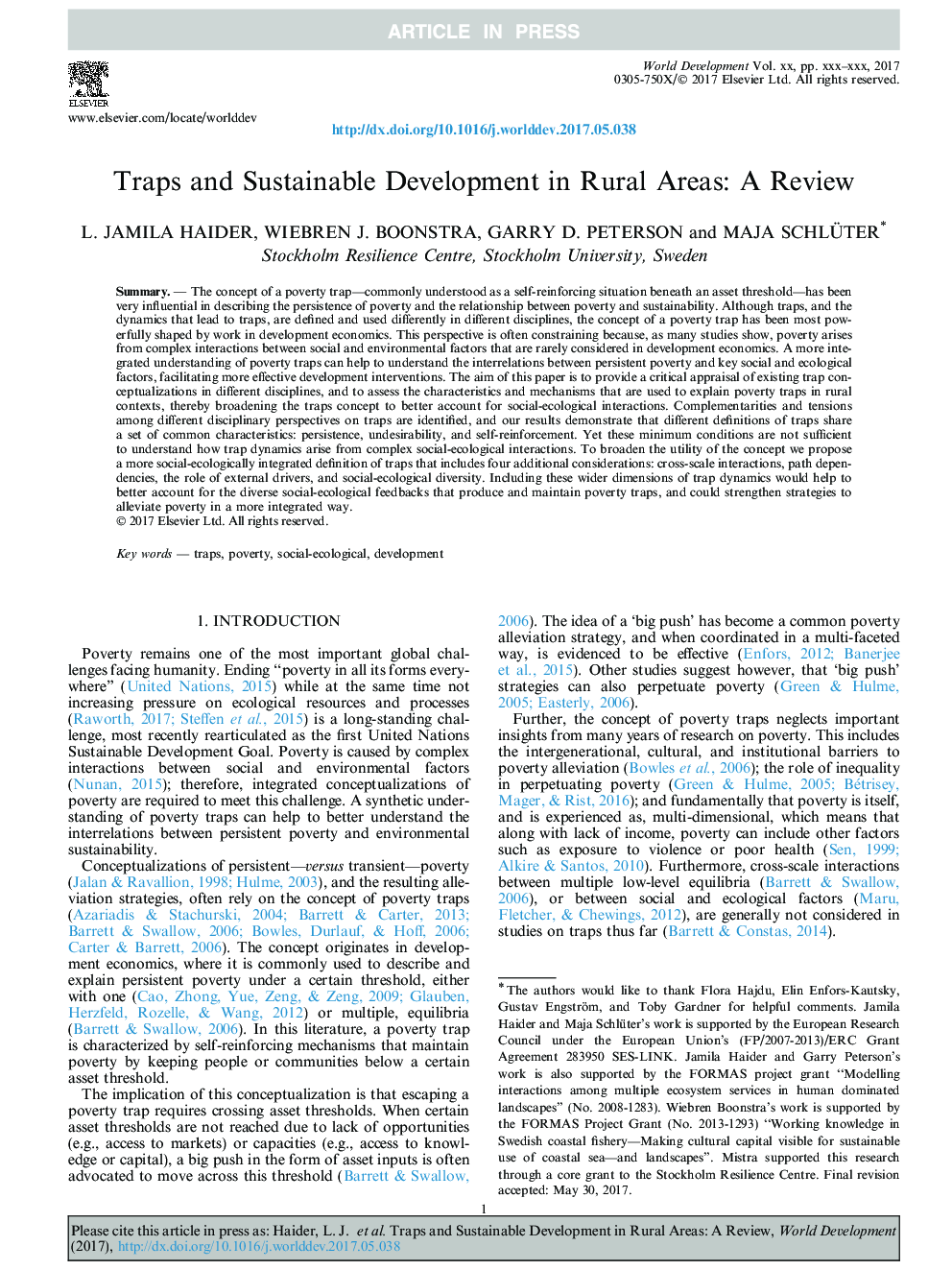| کد مقاله | کد نشریه | سال انتشار | مقاله انگلیسی | نسخه تمام متن |
|---|---|---|---|---|
| 7392362 | 1481117 | 2018 | 12 صفحه PDF | دانلود رایگان |
عنوان انگلیسی مقاله ISI
Traps and Sustainable Development in Rural Areas: A Review
ترجمه فارسی عنوان
تله ها و توسعه پایدار در مناطق روستایی: یک مرور
دانلود مقاله + سفارش ترجمه
دانلود مقاله ISI انگلیسی
رایگان برای ایرانیان
کلمات کلیدی
تله ها، فقر، اجتماعی-محیطی، توسعه،
ترجمه چکیده
مفهوم تله فقر که معمولا به عنوان یک وضعیت تقویت کننده در زیر آستانه دارایی شناخته می شود، در توصیف پایداری فقر و رابطه بین فقر و پایداری بسیار تاثیر گذار بوده است. گرچه تله ها و پویایی هایی که به تله ها منجر می شود، در رشته های مختلف تعریف و مورد استفاده قرار می گیرند، مفهوم تله فقر به شدت توسط کار در اقتصاد توسعه شکل گرفته است. این دیدگاه اغلب محدودیت دارد، زیرا مطالعات بسیاری نشان می دهد فقر ناشی از تعاملات پیچیده بین عوامل اجتماعی و محیطی است که به ندرت در اقتصاد توسعه دیده می شوند. یکپارچه سازی درک تله های فقر می تواند به درک روابط میان فقر پایدار و عوامل کلیدی اجتماعی و زیست محیطی کمک کند تا مداخلات توسعه موثرتر را تسهیل نمایند. هدف این مقاله ارائه ارزیابی انتقادی از مفهوم سازی تله موجود در رشته های مختلف و ارزیابی ویژگی ها و مکانیزم هایی است که برای تشریح تله های فقر در زمینه های روستایی مورد استفاده قرار می گیرند، در نتیجه گسترش مفهوم تله ها به منظور بهتر شدن تعاملات اجتماعی-محیطی . هم افزایی و تنش در بین دیدگاه های انضباطی در مورد تله ها شناسایی شده و نتایج ما نشان می دهد که تعاریف مختلف تله ها دارای مجموعه ای از ویژگی های مشترک است: پایداری، عدم تمایل و تقویت خود. با این حال این شرایط حداقل برای فهمیدن اینکه چگونه پویایی دامنه از تعاملات پیچیده اجتماعی-اکولوژیکی منجر می شود کافی نیست. برای گسترش مفهوم مفهوم، ما یک تعریف اجتماعی و اکولوژیکی یکپارچه از تله ها ارائه می دهیم که شامل چهار ملاحظات اضافی می شود: تعاملات مقطعی، وابستگی های مسیر، نقش رانندگان خارجی و تنوع اجتماعی و زیست محیطی. از جمله این ابعاد وسیع تر پویایی تله ها می تواند به بهتر شدن پاسخ های متنوع اجتماعی و اکولوژیکی که باعث تولید و حفظ تله های فقر می شود کمک کند و می تواند استراتژی هایی را برای کاهش فقر در یک راه جامع تر تقویت کند.
موضوعات مرتبط
علوم انسانی و اجتماعی
اقتصاد، اقتصادسنجی و امور مالی
اقتصاد و اقتصادسنجی
چکیده انگلیسی
The concept of a poverty trap-commonly understood as a self-reinforcing situation beneath an asset threshold-has been very influential in describing the persistence of poverty and the relationship between poverty and sustainability. Although traps, and the dynamics that lead to traps, are defined and used differently in different disciplines, the concept of a poverty trap has been most powerfully shaped by work in development economics. This perspective is often constraining because, as many studies show, poverty arises from complex interactions between social and environmental factors that are rarely considered in development economics. A more integrated understanding of poverty traps can help to understand the interrelations between persistent poverty and key social and ecological factors, facilitating more effective development interventions. The aim of this paper is to provide a critical appraisal of existing trap conceptualizations in different disciplines, and to assess the characteristics and mechanisms that are used to explain poverty traps in rural contexts, thereby broadening the traps concept to better account for social-ecological interactions. Complementarities and tensions among different disciplinary perspectives on traps are identified, and our results demonstrate that different definitions of traps share a set of common characteristics: persistence, undesirability, and self-reinforcement. Yet these minimum conditions are not sufficient to understand how trap dynamics arise from complex social-ecological interactions. To broaden the utility of the concept we propose a more social-ecologically integrated definition of traps that includes four additional considerations: cross-scale interactions, path dependencies, the role of external drivers, and social-ecological diversity. Including these wider dimensions of trap dynamics would help to better account for the diverse social-ecological feedbacks that produce and maintain poverty traps, and could strengthen strategies to alleviate poverty in a more integrated way.
ناشر
Database: Elsevier - ScienceDirect (ساینس دایرکت)
Journal: World Development - Volume 101, January 2018, Pages 311-321
Journal: World Development - Volume 101, January 2018, Pages 311-321
نویسندگان
L. Jamila Haider, Wiebren J. Boonstra, Garry D. Peterson, Maja Schlüter,
